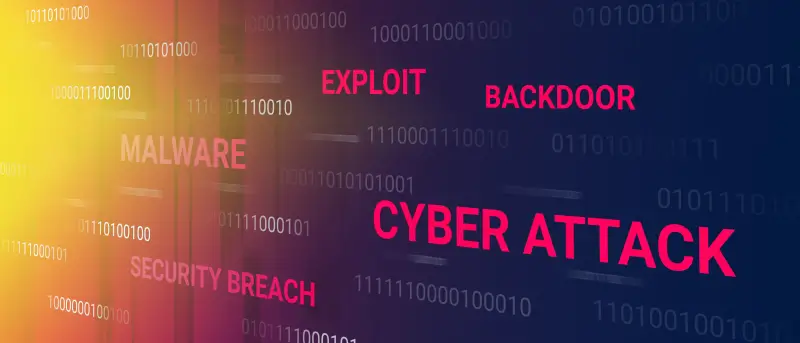Cyber-related crime is one of the most significant risks faced by any organization. It can lead to severe financial loss, reputation damage and the leak of operational data. Business owners should worry about the disruptive potential of cyber attacks on their operations.
There’s also a legal risk. Organizations handle vast amounts of personally identifiable information. For example, credit card data, home addresses, and contact information are all part of doing business for many companies.
Personal information is protected by US federal and state laws, such as the California Consumer Privacy Act (CCPA) and the EU’s GDPR legislation. Sometimes, data loss from a cyberattack may be followed by lawsuits from clients, customers, or employees.
This all adds to the potential financial risk of cyberattacks. The combined cost of attorney fees, settlements, and regulatory fines can be devastating.
What Are The Common Cyberattacks To Watch Out For In 2024?

One of the biggest cybersecurity challenges is the evolving nature of attacks. As IT systems continue to change, so do threats that can evade security.
The US Government Accountability Office (GAO) notes that cybersecurity incidents are increasing in quantity, risk, and cost. Incidents recorded against federal IT systems include the following common kinds of cyber attacks:
- Phishing Attacks - Compromising email accounts to steal funds. There are different types of phishing attacks, including whale and spear attacks. Whale Phishing focuses on large organizations. With Spear phishing, the attacker takes the time to investigate their intended targets and creates messages that the victim will likely find personally relevant.
- Denial of Service Attack (DoS & DDoS) - Prevents the use of networked services by flooding the system with traffic or data to overwhelm the system. These attacks cause the system to go down because it's unable to handle this much traffic.
- Ransomware - Malware that denies access to business IT systems until a “ransom” is paid.
- Man in the Middle (MITM) - In this type of attack, the perpetrator can “listen in” on the information being sent back and forth between people, networks, or computers. Here, the attacker is attempting to gather important information.
These are just some of the types of attacks to look out for. In fact, there are over 20 different types of cyber attacks. Cybersecurity is a vast, complex topic requiring expert-level skills to keep an organization’s infrastructure safe. It requires understanding the latest threats and knowing about potential exploits. IT security also depends on employee behavior and educating the staff about risky practices that could increase the likelihood of a data breach.
Categorizing Cyber Attacks
Cyber attacks fall into two categories. Technically sophisticated hacks probe an organization’s defenses, seeking to exploit security gaps. Social engineering attacks, such as phishing emails, aim to deceive people into sharing information or downloading malicious files. This includes passwords, login credentials, and information that can enable wider data breaches.
Both are a risk to organizations. Even with strong security in place, unknowns are always hard to anticipate. No business should ever consider itself immune to cyberattacks.
For that reason, organizations of all sizes should plan for the inevitable. A cyberattack is likely to happen at some point.
How Cybersecurity Insurance Protects Against The Financial Risk

While a robust security policy is part of the solution to cyberattacks, it cannot mitigate the potential for financial loss. The aforementioned legal and financial risks are a challenge the business will likely have to deal with at some point.
Businesses can take out insurance against cyberattacks to protect themselves from financial losses if the worst happens. But traditional insurance models treat cyberattacks differently from, for example, disasters like fire, flooding or physical theft. Cybersecurity coverage may be available as an add-on for an existing policy. But equally, insurance firms also offer separate policies exclusively dedicated to cybersecurity risks.
It’s worth considering the full scope of potential financial expenses from a cyberattack in more detail.
If a business is hacked or suffers a data breach, it may lead to systems going offline and losing trade.
Risk assessment and analysis of the incident can be a lengthy and costly process, potentially requiring third-party technical support. There may need to be a communications campaign to manage customer relations. Ransomware can incur costs to recover from.
Then, there is the potential for court and attorney fees incurred by legal challenges.
This includes fines for non-compliance and court judgments, which soon become expensive.
First-party cybersecurity insurance may cover the financial consequences of a cyberattack.
Cybersecurity insurance typically covers the following:
- Data Breaches: Most of the time, cyber insurance can cover the cost of investigating a breach, legal expenses related to the breach, and the cost of notifying affected parties.
- Extortion: This is where hackers take control of resources via ransomware and demand payment. Insurance may cover the payout.
- Business Interruption: Cyber insurance may cover losses if your business cannot operate normally following a cyberattack.
- Cybercrime: Coverage for financial losses due to fraudulent electronic transfers and theft of funds.
Additionally, third-party insurance covers expenses if your business is sued for damages due to a cyberattack. This typically covers legal fees, payouts, and fines for non-compliance.
Does your business need cyber insurance?
Cyber insurance makes the most sense for organizations that handle customer data, such as retail industries. This could include anything from credit card numbers to personal email addresses. In the USA, by law, you may be required to notify customers in the event of a successful attack. If this sounds like your organization, then insurance may well be worth it.
Cyber insurance may not seem as crucial if your business doesn’t depend on customer data. However, there’s still the risk of losing data from employees and suppliers. Additionally, first-party insurance covers you for expenses that any organization may have to consider in the event of an attack.
Conclusion
Cybersecurity insurance is designed to complement, rather than replace, robust IT security practices within an organization. It’s sensible to assume it’s only a matter of time before a successful cyberattack is carried out. This is certain to incur a financial cost.
Cybersecurity insurance is one way to mitigate that risk. We suggest speaking to your current insurance provider to determine what your current policy covers. It may help to ask whether the listed scenarios are not part of your existing agreement. If you still need to, consider extending your current policy or taking out a new policy that guarantees coverage.









